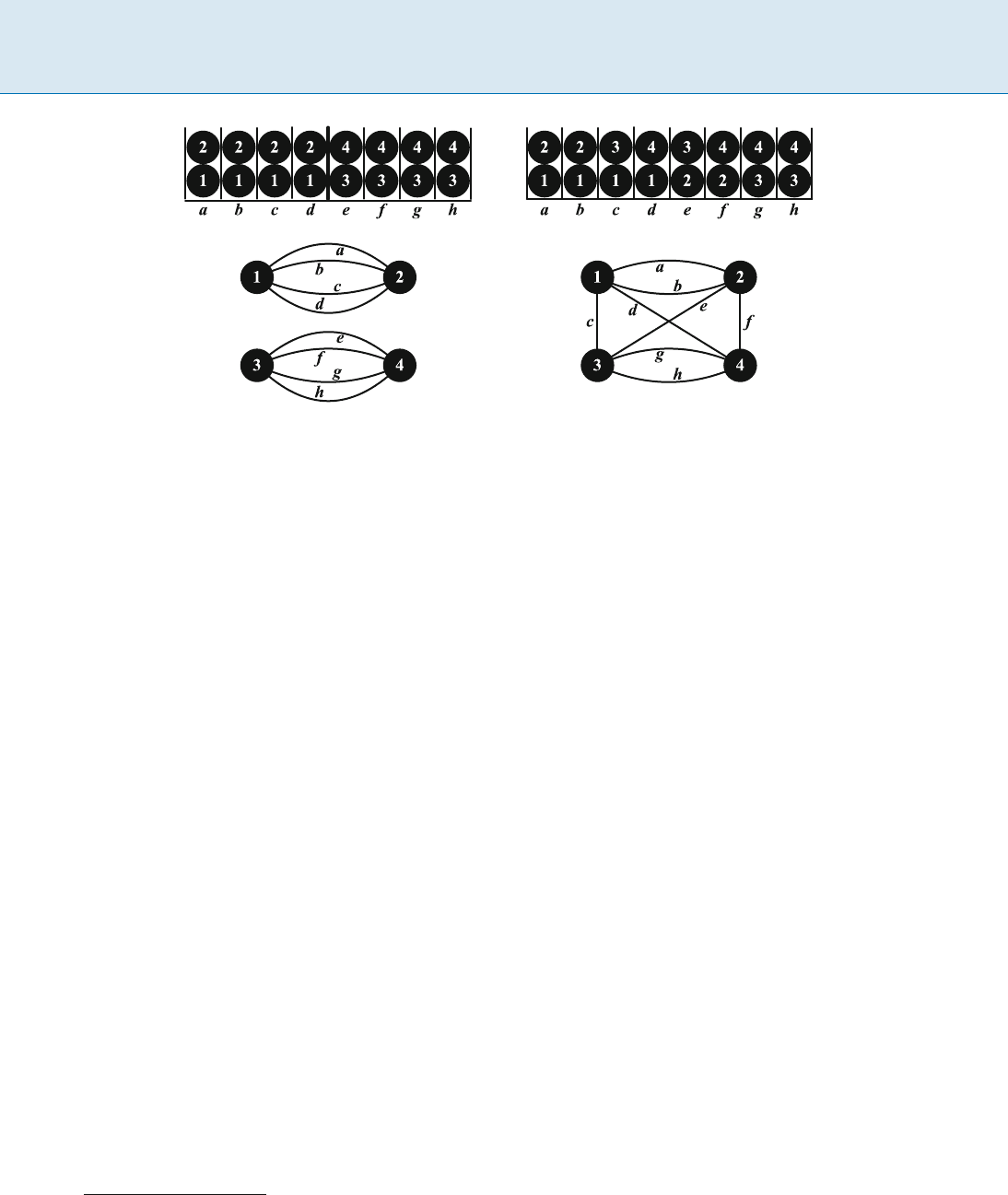Kao M.-Y. (ed.) Encyclopedia of Algorithms
Подождите немного. Документ загружается.


518 M Metric TSP
Input: a complete loopless edge weighted undirected
graph G =(V; E; w) with weight function w : E !
Q
0
that fulfills the triangle inequality
Output: a Hamiltonian tour of G that is a 2" approxi-
mation
1: Compute a minimum spanning tree T of G.
2: Duplicate each edge of T and obtain a Eulerian mul-
tigraph T
0
.
3: Compute a Eulerian tour of T
0
(for instance via a
depth first search in T). Whenever a node is visited
in the Eulerian tour that was already visited, this
node is skipped and one proceeds with the next un-
visited node along the Eulerian cycle. (This process
is called shortcutting.) Return the resulting Hamil-
tonian tour H.
Metric TSP, Algorithm 1
Tree doubling algorithm
Lemma 1 Let T be a minimum spanning tree of G =
(V; E; w).Thenw(T) OPT.
Proof If one deletes any edge of a Hamiltonian tour of G,
one gets a spanning tree of G.
Theorem 2 Algorithm 1 always returns a Hamiltonian
tourwhoseweightisatmosttwicetheweightofanopti-
mum tour. Its running time is polynomial.
Proof By Lemma 1, w(T) OPT. Since one duplicates
each edge of T, the weight of T
0
equals w(T
0
)=2w(T)
2OPT. When taking shortcuts in step 3, a path in T
0
is
replacedbyasingleedge.Bythetriangleinequality,the
sum of the weights of the edges in such a path is at least
the weight of the edge it is replaced by. (Here, the algo-
rithm breaks down for arbitrary weight functions.) Thus
w(H) w(T
0
). This proves the claim about the approxi-
mation performance.
The running time is dominated by the time needed to
compute a minimum spanning tree. This is clearly polyno-
mial.
Christofides’ algorithm (Algorithm 2) is a clever refine-
ment of the tree doubling algorithm. It first computes
a minimum spanning tree. On the nodes that have an odd
degree in T, it then computes a minimum weight perfect
matching. A matching M of G is called a matching on
U V if all edges of M consist of two nodes from U.Such
a matching is called perfect if every node of U is incident
with an edge of M.
Lemma 3 Let U V; #U even. Let M be a minimum
weight perfect matching on U. Then w(M) OPT/2.
Input: a complete loopless edge weighted undirected
graph G =(V; E; w) with weight function w : E !
Q
0
that fulfills the triangle inequality
Output: a Hamiltonian tour of G that is a 3/2" approxi-
mation
1: Compute a minimum spanning tree T of G.
2: Let U V be the set of all nodes that have odd de-
gree in T.InG, compute a minimum weight per-
fect matching M on U.
3: Compute a Eulerian tour of T [ M (considered as
amultigraph).
4: Take shortcuts in this Eulerian tour to a Hamilto-
nian tour H.
Metric TSP, Algorithm 2
Christofides’ algorithm
Proof Let H be an optimum Hamiltonian tour of G.One
takes shortcuts in H to get a tour H
0
on G|
U
as follows:
H induces a permutation of the nodes in U,namelythe
order in which the nodes are visited by H. One connects
the nodes of U in the order given by the permutation.
To every edge of H
0
corresponds a path in H connect-
ing the two nodes of this edge. By the triangle inequality,
w(H
0
) w(H). Since #U is even, H
0
is the union of two
matchings. The lighter one of these two has a weight of at
most w(H
0
)/2 OPT/2.
One can compute a minimum weight perfect matching in
time O(n
3
), see for instance [5].
Theorem 4 Algorithm 2 is a 3/2-approximation algorithm
with polynomial running time.
Proof First observe that the number of odd degree nodes
of the spanning tree is even, since the sum of the degrees
of all nodes equals 2(n 1), which is even. Thus a per-
fect matching on U exists. The weight of the Eulerian tour
is obviously w(T)+w(M). By Lemma 1, w(T) OPT. By
Lemma 3, w(M) OPT/2. The weight w(H)ofthecom-
puted tour H is at most the weight of the Eulerian tour by
the triangle inequality, i. e., w(H)
3
2
OPT. Thus the algo-
rithm is a 3/2-approximation algorithm. Its running time
is O(n
3
).
Applications
Experimental analysis shows that Christofides’ algorithm
itself deviates by 10% to 15% from the optimum tour [3].
However, it can serve as a good starting tour for other
heuristics like the Lin–Kernigham heuristic.

Minimum Bisection M 519
Metric TSP, Figure 1
A tight example for Christofides’ algorithm. There are 2n +1
nodes. Solid edges have a weight of one, dashed ones have
aweightof1+
Open Problems
The analysis of Algorithm 2 is tight; an example is the met-
ric completion of the graph depicted in Fig. 1. The unique
minimum spanning tree consists of all solid edges. It has
only two nodes of odd degree. The edge between these two
nodes has weight (1 + )(n + 1). No shortcuts are needed,
and the weight of the tour produced by the algorithm is
3n. An optimum tour consists of all dashed edges plus
the leftmost and rightmost solid edge. The weight of this
tour is (2n 1)(1 + )+2 2n.
The question whether there is an approximation algo-
rithm with a better performance guarantee is a major open
problem in the theory of approximation algorithms.
Held and Karp [2] design an LP based algorithm that
computes a lower bound for the weight of an optimum
TSP tour. It is conjectured that the weight of an optimum
TSP tour is at most a factor of 4/3 larger than this lower
bound, but this conjecture is unproven for more than three
decades. An algorithmic proof of this conjecture would
yield an 4/3-approximation algorithm for the Metric TSP.
Experimental Resul t s
See e. g. [3], where a deviation of 10% to 15% of the opti-
mum (more precisely of the Held–Karpbound) is reported
for various sorts of instances.
Data Sets
The webpage of the 8th DIMACS implementation chal-
lenge, www.research.att.com/~dsj/chtsp/,containsalotof
instances.
Cross References
Minimum Spanning Trees
Recommended Reading
Christofides never published his algorithm. It is usually
cited as one of two technical reports from Carnegie Mellon
University, TR 388 of the Graduate School of Industrial
Administration (now Tepper School of Business) and CS-
93-13. None of them seem to be available at Carnegie Mel-
lon University anymore [Frank Balbach, personal com-
munication, 2006]. A one-page abstract was published in
a conference record. But his algorithm quickly found his
way into standard textbooks on algorithm theory, see [7]
for a recent one.
1. Christofides, N.: Worst case analysis of a new heuristic for the
traveling salesman problem, Technical Report 388, Graduate
School of Industrial Administration, Carnegie-Mellon University,
Pittsburgh, (1976). Also: Carnegie-Mellon University Technical
Report CS-93-13, 1976. Abstract in Traub, J.F. (ed.) Symposium
on new directions and recent results in algorithms and com-
plexity, pp. 441. Academic Press, New York (1976)
2. Held, M., Karp, R.M.: The traveling salesman problem and mini-
mum spanning trees. Oper. Res. 18, 1138–1162 (1970)
3. Johnson, D.S., McGeoch, L.A.: Experimental analysis of heuristics
for the STSP. In: Gutin, G., Punnen, A.P. (eds.) The Traveling Sales-
man Problem and its Variations. Kluwer, Dordrecht (2002)
4. Lawler, E.L., Lenstra, J.K., Rinnooy Kan, A.H.G., Shmoys, D.B.
(eds.): The Traveling Salesman Problem. A Guided Tour of Com-
binatorial Optimization. Wiley, Chichester (1985)
5. Papadimitriou, C., Steiglitz, K.: Combinatorial Optimization:
Algorithms and Complexity. Prentice-Hall, Englewood Cliffs
(1982)
6. Sahni, S., Gonzalez, T.: P-complete approximation problems.
J. ACM 23, 555–565 (1976)
7. Vazirani, V.V.: Approximation Algorithms. Springer, Berlin (2001)
8. Traveling Salesman Problem. www.tsp.gatech.edu (2006). Ac-
cessed 28 Mar 2008
Minimum Bisection
1999; Feige, Krauthgamer
ROBERT KRAUTHGAMER
1,2
1
Weizmann Institute of Science, Rehovot, Israel
2
IBM Almaden Research Center, San Jose, CA, USA
Keywords and Synonyms
Graph bisection
Problem Definition
Overview
Minimum bisection is a basic representative of a family of
discrete optimization problems dealing with partitioning
the vertices of an input graph. Typically, one wishes to
minimize the number of edges going across between the
different pieces, while keeping some control on the parti-
tion, say by restricting the number of pieces and/or their
size. (This description corresponds to an edge-cut of the
graph; other variants correspond to a vertex-cut with sim-
ilar restrictions.) In the minimum bisection problem, the

520 M Minimum Bisection
goal is to partition the vertices of an input graph into two
equal-size sets, such that the number of edges connecting
the two sets is as small as possible.
In a seminal paper in 1988, Leighton and Rao [14]de-
vised for M
INIMUM-BISECTION a logarithmic-factor bi-
criteria approximation algorithm.
1
Their algorithm has
found numerous applications, but the question of finding
a true approximation with a similar factor remained open
for over a decade later. In 1999, Feige and Krauthgamer [6]
devised the first polynomial-time algorithm that approxi-
mates this problem within a factor that is polylogarithmic
(in the graph size).
Cuts and Bisections
Let G =(V; E) be an undirected graph with n = jVj ver-
tices, and assume for simplicity that n is even. For a sub-
set S of the vertices, let
¯
S = V n S.Thecut (also known as
cutset)(S;
¯
S) is defined as the set of all edges with one end-
point in S and one endpoint in
¯
S. These edges are said to
cross the cut, and the two sets S and
¯
S are called the two
sides of the cut.
Assume henceforth that G has nonnegative edge-
weights. (In the unweighted version, every edge has a unit
weight.) The cost of a cut (S;
¯
S) is then defined to be the
total edge-weight of all the edges crossing the cut.
Acut(S;
¯
S) is called a bisection of G if its two sides have
equal cardinality, namely jSj = j
¯
Sj = n/2. Let b(G)denote
the minimum cost of a bisection of G.
Problem 1 (MINIMUM-BISECTION)
Input: An undirected graph G with nonnegative edge-
weights.
Output:Abisection(S;
¯
S) of G that has minimum cost.
This definition has a crucial difference from the classi-
cal M
INIMUM-CUT problem (see e. g. [10] and references
therein), namely, there is a restriction on the sizes of the
two sides of the cut. As it turns out, M
INIMUM-BISECTION
is NP-hard (see [9]), while MINIMUM-CUT can be solved
in polynomial time.
Balanced Cuts and Edge Separators
The above rather basic definition of minimum bisec-
tion can be extended in several ways. Specifically, one
may require only an upper bound on the size of each
side. For 0 <ˇ<1, a cut (S;
¯
S) is called ˇ-balanced if
maxfjSj; j
¯
Sjg ˇn. Note the latter requirement implies
1
A bicriteria approximation algorithm partitions the vertices into
two sets each containing at most 2/3 of the vertices, and its value, i. e.
the number of edges connecting the two sets, is compared against that
of the best partition into equal-size sets.
minfjSj; j
¯
Sjg (1 ˇ)n.Inthisterminology,abisection
is a 1/2-balanced cut.
Problem 2 (ˇ-B
ALANCED-CUT)
Input: An undirected graph G with nonnegative edge-
weights.
Output:Aˇ-balanced cut (S;
¯
S) of G with maxfjSj; j
¯
Sjg
ˇn, that has cost as small as possible.
The special case of ˇ = 2/3 is commonly refered to as the
E
DGE-SEPARATOR problem.
In general, the sizes of the two sides may be specified
in advance arbitrarily (rather than being equal); in this case
the input contains a number k, and the goal is to find a cut
(S;
¯
S)suchthatjSj = k. One may also wish to divide the
graph into more than two pieces of equal size and then the
input contains a number r 2, or alternatively, to divide
the graph into r pieces of whose sizes are k
1
,...,k
r
,where
the numbers k
i
are prescribed in the input; in either case,
the goal is to minimize the number of edges crossing be-
tween different pieces.
Problem 3 (P
RESCRIBED-PARTITION)
Input:AnundirectedgraphG=(V; E) with nonnegative
edge-weights, and integers k
1
,...,k
r
such that
P
i
k
i
= jVj.
Output: A partition V = V
1
[[V
r
of G with jV
i
j = k
i
for all i, such that the total edge-weight of edges whose end-
points lie in different sets V
i
is as small as possible.
Key Results
The main result of Feige and Krauthgamer [6]isanap-
proximation algorithm for M
INIMUM-BISECTION.The
approximation factor they originally claimed is O(log
2
n),
because it used the algorithm of Leighton and Rao [14];
however, by using instead the algorithm of [2], the factor
immediately improves to O(log
1:5
n).
Theorem 1 Minimum-Bisection can be approximated in
polynomial time within O(log
1:5
n) factor. Specifically, the
algorithm produces for an input graph G a bisection (S;
¯
S)
whose cost is at most O(log
1:5
n) b(G).
The algorithm immediately extends to similar results for
related and/or more general problems that are defined
above.
Theorem 2 ˇ-Balanced-Cut (and in particular Edge-
Separator) can be approximated in polynomial time within
O(log
1:5
n) factor.
Theorem 3 Prescribed-Partition can be approximated in
time n
O(r)
to within O(log
1:5
n) factor.
For all three problems above, the approximation ratio
improves to O(log n)forthefamilyofgraphsexcluding

Minimum Bisection M 521
a fixed minor (which includes in particular planar graphs).
For simplicity, this result is stated for Minimum-Bisection.
Theorem 4 In graphs excluding a fixed graph as a minor
(e. g., planar graphs), the problems (i) Minimum-Bisection,
(ii) ˇ-Balanced-Cut, and (iii) Prescribed-Partition with
fixed r can all be approximated in polynomial time within
factor O(log n).
It should be noted that all these results can be generalized
further, including vertex-weights and terminals-vertices
(s t pairs), see [Sect. 5 in 6].
Related Work
A bicriteria approximation algorithm for ˇ-balanced cut
returns a cut that is ˇ
0
-balanced for a predetermined
ˇ
0
>ˇ.Forbisection,forexample,ˇ = 1/2 and typically
ˇ
0
=2/3.
The algorithms in the above theorems use (in a black-
box manner) an approximation algorithm for a problem
called minimum quotient-cuts (or equivalently, sparsest-
cut with uniform-demands). For this problem, the best
approximation currently known is O(
p
log n)forgen-
eral graphs due to Arora, Rao, and Vazirani [2], and
O(1) for graphs excluding a fixed minor due to Klein,
Plotkin, and Rao [13]. These approximation algorithms
for minimum quotient-cuts immediately give a poly-
nomial time bicriteria approximation (sometimes called
pseudo-approximation) for M
INIMUM-BISECTION.For
example, in general graphs the algorithm is guaranteed
to produce a 2/3-balanced cut whose cost is at most
O(
p
log n) b(G). Note however that a 2/3-balanced cut
does not provide a good approximation for the value of
b(G). For instance, if G consists of three disjoint cliques
of equal size, an optimal 2/3-balanced cut has no edges,
whereas b(G)=˝(n
2
). For additional related work, in-
cluding approximation algorithms for dense graphs, for
directed graphs, and for other graph partitioning prob-
lems, see [Sect. 1 in 6] and the references therein.
Applications
One major motivation for M
INIMUM-BISECTION,and
graph partitioning in general, is a divide-and-conquer ap-
proach to solving a variety of optimization problems, es-
pecially in graphs, see e. g. [15,16]. In fact, these problems
arise naturally in a wide range of practical settings such as
VLSI design and image processing; sometimes, the moti-
vation is described differently, e. g. as a clustering task.
Another application of M
INIMUM-BISECTION is in as-
signment problems, of a form that is common in paral-
lel systems and in scientific computing: jobs need to be
assigned to machines in a balanced way, while assigning
certain pairs of jobs the same machine, as much as possi-
ble. For example, consider assigning n jobs to 2 machines,
when the amount of communication between every two
jobs is known, and the goal is to have equal load (number
of jobs) on each machine, and bring to minimum the total
communication that goes between the machines. Clearly,
this last problem can be restated as M
INIMUM-BISECTION
in a suitable graph.
It should be noted that in many of these settings, a true
approximation is not absolutely necessary, and a bicriteria
approximation may suffice. Nevertheless, the algorithms
stated in Sect. “Key Results” have been used to design al-
gorithms for other problems, such as (1) an approxima-
tion algorithm for minimum bisection in k-uniform hy-
pergraphs [3]; (2) an approximation algorithm for a vari-
ant of the minimum multicut problem [17]; and (3) an al-
gorithm that efficiently certifies the unsatisfiability of ran-
dom 2k-SAT with sufficiently many clauses [5].
From a practical perspective, numerous heuristics (al-
gorithms without worst-case guarantees) for graph par-
titioning have been proposed and studied, see [1]foran
extensive survey. For example, one of the most famous
heuristics is Kerninghan and Lin’s local search heuristic
for minimum bisection [11].
Open Problems
Currently, there is a large gap between the O(log
1:5
n)
approximation ratio for M
INIMUM-BISECTION achieved
by Theorem 1 and the hardness of approximation results
known for it. As mentioned above, M
INIMUM-BISECTION
is known to be NP-hard (see [9]).
The problem is not known to be APX-hard but sev-
eral results provide evidence towards this possibility. Bui
and Jones [4] show that for every fixed >0, it is NP-hard
to approximate the minimum bisection within an additive
term of n
2
.Feige[7] showed that if refuting 3SAT is
hard on average on a natural distribution of inputs, then
for every fixed ">0thereisno4/3" approximation
algorithm for minimum bisection. Khot [12] proved that
minimum bisection does not admit a polynomial-time ap-
proximation scheme (PTAS) unless NP has randomized
sub-exponential time algorithms.
Taking a broader perspective, currently there is a (mul-
tiplicative) gap of O(log n) between the approximation
ratio for M
INIMUM-BISECTION and that of minimum
quotient-cuts (and thus also to the factor achieved by bi-
criteria approximation). It is interesting whether this gap
can be reduced, e. g. by using the algorithm of [2] in a non-
black box manner.

522 M Minimum Congestion Redundant Assignments
The vertex-cutversion of MINIMUM-BISECTION is de-
fined as follows: the goal is to partition the vertices of the
input graph into V = A [ B [ S with jSj as small as possi-
ble, under the constraints that maxfjAj; jBjg n/2 and no
edge connects A with B. It is not known whether a poly-
logarithmic factor approximation can be attained for this
problem. It should be noted that the same question regard-
ing the directed version of M
INIMUM-BISECTION was an-
swered negatively by Feige and Yahalom [8].
Cross References
See entry on the paper by Arora, Rao, and Vazirani [2].
Separators in Graphs
Sparsest Cut
Recommended Reading
1. Alpert, C.J., Kahng, A.B.: Recent directions in netlist partition-
ing: a survey. Integr. VLSI J. 19(1–2), 1–81 (1995)
2. Arora, S., Rao, S., Vazirani, U.: Expander flows, geometric em-
beddings, and graph partitionings. In: 36th Annual Sympo-
sium on the Theory of Computing, pp. 222–231, Chicago, June
2004
3. Berman, P., Karpinski, M.: Approximability of hypergraph mini-
mum bisection. ECCC Report TR03-056, Electronic Colloquium
on Computational Complexity, vol. 10 (2003)
4. Bui, T.N., Jones, C.: Finding good approximate vertex and edge
partitions is NP-hard. Inform. Process. Lett. 42(3), 153–159
(1992)
5. Coja-Oghlan, A., Goerdt, A., Lanka, A., Schädlich, F.: Techniques
from combinatorial approximation algorithms yield efficient
algorithms for random 2k-SAT. Theor. Comput. Sci. 329(1–3),
1–45 (2004)
6. Feige, U., Krauthgamer, R.: A polylogarithmic approximation
of the minimum bisection. SIAM Review 48(1), 99–130 (2006)
(Previous versions appeared in Proceedings of 41st FOCS,
1999; and in SIAM J. Comput. 2002)
8. Feige, U., Yahalom, O.: On the complexity of finding balanced
oneway cuts. Inf. Process. Lett. 87(1), 1–5 (2003)
7. Feige, U.: Relations between average case complexity and ap-
proximation complexity. In: 34th Annual ACM Symposium on
the Theory of Computing, pp. 534–543, Montréal, May 19–21,
2002
9. Garey, M.R., Johnson, D.S.: Computers and Intractability: A
Guide to the Theory of NP-completeness. W.H. Freeman and
Company (1979)
10. Karger, D.R.: Minimum cuts in near-linear time. J. ACM 47(1),
46–76 (2000)
11. Kernighan, B.W., Lin, S.: An efficient heuristic procedure for par-
titioning graphs. Bell Syst. Tech. J. 49(2), 291–307 (1970)
12. Khot, S.: Ruling out PTAS for graph Min-Bisection, Densest Sub-
graph and BipartiteClique. In: 45th Annual IEEE Symposium on
Foundations of Computer Science, pp. 136–145, Georgia Inst.
of Technol., Atlanta 17–19 Oct. 2004
13. Klein, P., Plotkin, S.A., Rao, S.: Excluded minors, network de-
composition, and multicommodity flow. In: 25th Annual ACM
Symposium on Theory of Computing, pp. 682–690, San Diego,
1993 May 16–18
14. Leighton, T., Rao, S.: Multicommodity max-flow min-cut the-
orems and their use in designing approximation algorithms.
J. ACM 46(6), 787–832, 29th FOCS, 1988 (1999)
15. Lipton, R.J., Tarjan, R.E.: Applications of a planar separator the-
orem.SIAMJ.Comput.9(3), 615–627 (1980)
16. Rosenberg, A.L., Heath, L.S.: Graph separators, with ap-
plications. Frontiers of Computer Science. Kluwer Aca-
demic/Plenum Publishers, New York (2001)
17. Svitkina, Z., Tardos, É.: Min-Max multiway cut. In: 7th Interna-
tional workshop on Approximation algorithms for combinato-
rial optimization (APPROX), pp. 207–218, Cambridge, 2004 Au-
gust 22–24
Minimum Congestion
Redundant Assignments
2002; Fotakis, Spirakis
DIMITRIS FOTAKIS
1
,PAUL SPIRAKIS
2
1
Department of Information and Communication
Systems Engineering, University of the Aegean,
Samos, Greece
2
Computer Engineering and Informatics, Research
and Academic Computer Technology Institute,
Patras University, Patras, Greece
Keywords and Synonyms
Minimum fault-tolerant congestion; Maximum fault-tol-
erant partition
Problem Definition
This problem is concerned with the most efficient use
of redundancy in load balancing on faulty parallel links.
More specifically, this problem considers a setting where
some messages need to be transmitted from a source to
a destination through some faulty parallel links. Each link
fails independently with a given probability, and in case of
failure, none of the messages assigned to it reaches the des-
tination
1
. An assignment of the messages to the links may
use redundancy, i. e. assign multiple copies of some mes-
sages to different links. The reliability of a redundant as-
signment is the probability that every message has a copy
1
This assumption is realistic if the messages are split into many
small packets transmitted in a round-robin fashion. Then the suc-
cessful delivery of a message requires that all its packets should reach
the destination.

Minimum Congestion Redundant Assignments M 523
Minimum Congestion Redundant Assignments, Figure 1
Two r edundant assignments of 4 unit size messages to 8 identical links. Both assign every message to 4 links and 2 messages to
every link. The corresponding graph is depicted below each assignment. The assignment on the left is the most reliable 2-partition-
ing assignment
2
. Lemma 3 implies that for every failure probability f,
2
is at least as reliable as any other assignment with
Cong() 2. For instance,
2
is at least as reliable as the assignment on the right. Indeed the reliability of the assignment on the
right is 1 4f
4
+2f
6
+4f
7
3f
8
, which is bounded from above by Rel(
2
)=1 2f
4
+ f
8
for all f 2 [0; 1]
on some active link, thus managing to reach the destina-
tion. Redundancy increases reliability, but also increases
the message load assigned to the links. A good assign-
ment should achieve high reliability and keep the maxi-
mum load of the links as small as possible.
The reliability of a redundant assignment depends on
its structure. In particular, the reliability of different as-
signments putting the same load on every link and using
thesamenumberofcopiesforeachmessagemayvarysub-
stantially (e. g. compare the reliability of the assignments
in Fig. 1). The crux of the problem is to find an efficient
way of exploiting redundancy in order to achieve high re-
liability and low maximum load
2
.
The work of Fotakis and Spirakis [1]formulatesthe
scenario above as an optimization problem called Mini-
mum Fault-Tolerant Congestion and suggests a simple and
provably efficient approach of exploiting redundancy. This
approach naturally leads to the formulation of another in-
teresting optimization problem, namely that of computing
an efficient fault-tolerant partition of a set of faulty parallel
links. [1] presents polynomial-time approximation algo-
rithms for computing a fault-tolerant partition of the links
and proves that combining fault-tolerant partitions with
standard load balancing algorithms results in a good ap-
proximation to Minimum Fault-Tolerant Congestion. To
the best knowledge of the entry authors, this work is the
first to consider the approximability of computing a re-
2
If one does not insist on minimizing the maximum load, a reli-
able assignment is constructed by assigning every message to the most
reliable links.
dundant assignment that minimizes the maximum load
of the links subject to the constraint that random faults
should be tolerated with a given probability.
Notations and Definitions
Let M denote a set of m faulty parallel links connecting
asources to a destination t,andletJ denote a set of n
messages to be transmitted from s to t.Eachlinki has
a rational capacity c
i
1 and a rational failure probabil-
ity f
i
2 (0; 1). Each message j has a rational size s
j
1.
Let f
max
max
i2M
ff
i
g denote the failure probability of
the most unreliable link. Particular attention is paid to the
special case of identical capacity links, where all capacities
areassumedtobeequalto1.
The reliability of a set of links M
0
, denoted Rel(M
0
), is
the probability that there is an active link in M
0
. Formally,
Rel(M
0
) 1
Q
i2M
0
f
i
. The reliability of a collection of
disjoint link subsets
M = fM
1
;:::;M
g, denoted Rel(M),
is the probability that there is an active link in every subset
of
M. Formally,
Rel(
M)
Y
`=1
Rel(M
`
)=
Y
`=1
0
@
1
Y
i2M
`
f
i
1
A
:
A redundant assignment : J 7! 2
M
n;is a function
that assigns every message j to a non-empty set of links
(j) M. An assignment is feasible for a set of links M
0
if for every message j, (j) \ M
0
¤;.Thereliability of an
assignment , denoted Rel(), is the probability that is

524 M Minimum Congestion Redundant Assignments
feasible for the actual set of active links. Formally,
Rel()
X
M
0
M
8j2J;(j)\M
0
¤;
0
@
Y
i2M
0
(1 f
i
)
Y
i2MnM
0
f
i
1
A
The congestion of an assignment , denoted Cong(), is
the maximum load assigned by to a link in M. Formally,
Cong() max
i2M
8
<
:
X
j: i2( j)
s
j
c
i
9
=
;
:
Problem 1 (Minimum Fault-Tolerant Congestion)
I
NPUT: A set of faulty parallel links M = f(c
1
; f
1
);:::;
(c
m
; f
m
)g, a set of messages J = fs
1
;:::;s
n
g, and a rational
number 2 (0; 1).
O
UTPUT: A redundant assignment : J 7! 2
M
n;with
Rel() 1 that minimizes Cong().
Minimum Fault-Tolerant Congestion is NP-hard because
it is a generalization of minimizing makespan on (reli-
able) parallel machines. The decision version of Minimum
Fault-Tolerant Congestion belongs to PSPACE, but it is
notclearwhetheritbelongstoNP. The reason is that com-
puting the reliability of a redundant assignment and decid-
ing whether it is a feasible solution is #P-complete.
The work of Fotakis and Spirakis [1] presents polyno-
mial-time approximation algorithms for Minimum Fault-
Tolerant Congestion based on a simple and natural class
of redundant assignments whose reliability can be com-
puted easily. The high level idea is to separate the re-
liability aspect from load balancing. Technically, the set
of links is partitioned in a collection of disjoint subsets
M = fM
1
;:::;M
g with Rel(M) 1 . Every subset
M
`
2 M is regarded as a reliable link of effective capacity
c(M
`
) min
i2M
`
fc
i
g. Then any algorithm for load bal-
ancing on reliable parallel machines can be used for as-
signing the messages to the subsets of
M,thuscomputing
a redundant assignment with Rel() 1 .
The assignments produced by this approach are
called partitioning assignments. More precisely, an as-
signment : J 7! 2
M
n;is a -partitioning assignment
if for every pair of messages j; j
0
,either(j)=(j
0
)or
(j) \ (j
0
)=;,and assigns the messages to differ-
ent link subsets.
Computing an appropriate fault-tolerant collection of
disjoint link subsets is an interesting optimization problem
by itself. A feasible solution
M satisfies the constraint that
Rel(
M) 1 . For identical capacity links, the most nat-
ural objective is to maximize the number of subsets in
M
(equivalently, the number of reliable links used by the load
balancing algorithm). For arbitrary capacities, this objec-
tive generalizes to maximizing the total effective capacity
of
M.
Problem 2 (Maximum Fault-Tolerant Partition)
I
NPUT: A set of faulty parallel links M = f(c
1
; f
1
);:::;
(c
m
; f
m
)g, and a rational number 2 (0; 1).
O
UTPUT: A collection M = fM
1
;:::;M
g of disjoint
subsets of M with Rel(
M) 1 that maximizes
P
`=1
c(M
`
).
The problem of Maximum Fault-Tolerant Partition is
NP-hard. More precisely, given m identical capacity links
with rational failure probabilities and a rational num-
ber 2 (0; 1), it is NP-complete to decide whether the
links can be partitioned into sets M
1
and M
2
with
Rel(M
1
) Rel(M
2
) 1 .
Key Results
Theorem 1 There is a 2-approximation algorithm for
Maximum Fault-Tolerant Partition of identical capacity
links. The time complexity of the algorithm is O((m
P
i2M
ln f
i
)lnm).
Theorem 2 For every constant ı>0,thereisa(8 + ı)-
approximation algorithm for Maximum Fault-Tolerant
Partition of capacitated links. The time complexity of the
algorithm is polynomial in the input size and 1/ı.
To demonstrate the efficiency of the partitioning approach
for Maximum Fault-Tolerant Congestion, Fotakis and
Spirakis prove that for certain instances, the reliability of
the most reliable partitioning assignment bounds from
above the reliability of any other assignment with the same
congestion (see Fig. 1 for an example).
Lemma 3 For any positive integers ; ; and any ra-
tional f 2 (0; 1),let be a redundant assignment of
unit size messages to identical capacity links with fail-
ure probability f . Let
be the -partitioning assignment
that assigns messages to each of disjoint subsets con-
sisting of links each. If Cong() = Cong(
),then
Rel() (1 f
)
= Rel(
).
Based on the previous upper bound on the reliability of
any redundant assignment, [1] presents polynomial-time
approximation algorithms for Maximum Fault-Tolerant
Congestion.
Theorem 4 There is a quasi-linear-time 4-approxima-
tion algorithm for Maximum Fault-Tolerant Congestion on
identical capacity links.

Minimum Congestion Redundant Assignments M 525
Theorem 5 There is a polynomial-time 2 dln(m/)/
ln(1/ f
max
)e-approximation algorithm for Maximum Fault-
Tolerant Congestion on instances with unit size messages
and capacitated links.
Applications
In many applications dealing with faulty components
(e. g. fault-tolerant network design, fault-tolerant routing),
a combinatorial structure (e. g. a graph, a hypergraph)
should optimally tolerate random faults with respect to
a given property (e. g. connectivity, non-existence of iso-
lated points). For instance, Lomonosov [5] derived tight
upper and lower bounds on the probability that a graph
remains connected under random edge faults. Using the
bounds of Lomonosov, Karger [3] obtained improved the-
oretical and practical results for the problem of estimating
the reliability of a graph. In this work, Lemma 3 provides
a tight upper bound on the probability that isolated nodes
do not appear in a not necessarily connected hypergraph
with nodes and “faulty” hyperedges of cardinal-
ity .
More precisely, let be any assignment of unit size
messages to identical links that assigns every message
to links and messages to every link. Then corre-
sponds to a hypergraph H
, where the set of nodes consists
of elements corresponding to the unit size messages
and the set of hyperedges consists of elements corre-
sponding to the identical links. Every hyperedge contains
the messages assigned to the corresponding link and has
cardinality (see Fig. 1 for a simple example with =2,
=2,and = 4). Clearly, an assignment is feasible for
asetoflinksM
0
M iff the removal of the hyperedges
corresponding to the links in M n M
0
does not leave any
isolated nodes
3
in H
. Lemma 3 implies that the hyper-
graph corresponding to the most reliable -partitioning
assignment maximizes the probability that isolated nodes
do not appear when hyperedgesare removed equiprobably
and independently.
The previous work on fault-tolerant network design
and routing mostly focuses on the worst-case fault model,
where a feasible solution must tolerate any configuration
of a given number of faults. The work of Gasieniec et
al. [2] studies the fault-tolerant version of minimizing con-
gestion of virtual path layouts in a complete ATM net-
work. In addition to several results for the worst-case fault
model, [2] constructs a virtual path layout of logarithmic
congestion that tolerates random faults with high proba-
bility. On the other hand, the work of Fotakis and Spirakis
3
For a node v,letdeg
H
(v) jfe 2 E(H):v 2 egj.Anodev is
isolated in H if deg
H
(v)=0.
shows how to construct redundant assignments that tol-
erate random faults with a probability given as part of the
input and achieve a congestion close to optimal.
Open Problems
An interesting research direction is to determine the com-
putational complexity of Minimum Fault-Tolerant Con-
gestion and related problems. The decision version of
Minimum Fault-Tolerant Congestion is included in the
class of languages decided by a polynomial-time non-de-
terministic Turing machine that reduces the language to
asinglecallofa#P oracle. After calling the oracle once, the
Turing machine rejects if the oracle’s outcome is less than
a given threshold and accepts otherwise. This class is de-
noted NP
#P[1;comp]
in [1]. In addition to Minimum Fault-
Tolerant Congestion, NP
#P[1;comp]
includes the decision
version of Stochastic Knapsack considered in [4]. A re-
sult of Toda and Watanabe [6]impliesthatNP
#P[1;comp]
contains the entire Polynomial Hierarchy. A challenging
open problem is to determine whether the decision ver-
sion of Minimum Fault-Tolerant Congestion is complete
for NP
#P[1;comp]
.
A second direction for further research is to con-
sider the generalizations of other fundamental optimiza-
tion problems (e. g. shortest paths, minimum connected
subgraph) under random faults. In the fault-tolerant ver-
sion of minimum connected subgraph for example, the
input consists of a graph whose edges fail independently
with given probabilities, and a rational number 2 (0; 1).
The goal is to compute a spanning subgraph with a mini-
mum number of edges whose reliability is at least 1 .
Cross References
Approximation Schemes for Bin Packing
Bin Packing
Connectivity and Fault-Tolerance in Random Regular
Graphs
List Scheduling
Recommended Reading
1. Fotakis, D., Spirakis, P.: Minimum Congestion Redundant As-
signments to Tolerate Random Faults. Algorithmica 32, 396–
422 (2002)
2. Gasieniec, L., Kranakis, E., Krizanc, D., Pelc, A.: Minimizing Con-
gestion of Layouts for ATM Networks with Faulty Links. In:
Penczek, W., Szalas, A. (eds.) Proceedings of the 21st Interna-
tional Symposium on Mathematical Foundations of Computer
Science. Lecture Notes in Computer Science, vol. 1113, pp. 372–
381. Springer, Berlin (1996)

526 M Minimum Energy Broadcasting in Wireless Geometric Networks
3. Karger, D.: A Randomized Fully Polynomial Time Approximation
Scheme for the All-Terminal Network Reliability Problem. SIAM
J. Comput. 29, 492–514 (1999)
4. Kleinberg, J., Rabani, Y., Tardos, E.: Allocating Bandwidth for
Bursty Connections. SIAM J. Comput. 30, 191–217 (2000)
5. Lomonosov, M.: Bernoulli Scheme with Closure. Probl. Inf.
Transm. 10, 73–81 (1974)
6. Toda, S., Watanabe, O.: Polynomial-Time 1-Turing Reductions
from #PH to #P.Theor.Comput.Sci.100, 205–221 (1992)
Minimum Energy Broadcasting
in Wireless Geometric Networks
2005; Ambühl
CHRISTOPH AMBÜHL
Department of Computer Science,
University of Liverpool, Liverpool, UK
Keywords and Synonyms
Energy-efficient broadcasting in wireless networks
Problem Definition
In the most common model for wireless networks, stations
are represented by points in R
d
. They are equipped with
a omnidirectional transmitter and receiver which enables
them to communicate with other stations. In order to send
amessagefromastations to a station t, station s needs
to emit the message with enough power such that t can
receive it. It is usually assumed that the power required by
a station s to transmit data directly to station t is kstk
˛
,
for some constant ˛ 1, where kstk denotes the distance
between s and t.
Because of the omnidirectional nature of the trans-
mitters and receivers, a message sent by a station s with
power r
˛
can be received by all stations within a disc of ra-
dius r around s. Hence the energy required to send a mes-
sage from a station s directly to a set of stations S
0
is deter-
mined by max
v2S
0
ksvk
˛
.
An instance of the minimum energy broadcast routing
problem in wireless networks (MEBR) consists of a set of
stations S and a constant ˛ 1. One of the stations in S
is designated as the source station s
0
.Thegoalistosend
a message at minimum energy cost from s
0
to all other sta-
tions in S. This operation is called broadcast.
In the case ˛ = 1, the optimal solution is to send the
message directly from s
0
to all other stations. For ˛>1,
sending the message via intermediate stations which for-
ward it to other stations is often more energy efficient.
A solution of the MEBR instance can be described in
terms of a so-called broadcast tree.Thatis,adirectedspan-
ning tree of S which contains directed paths from s
0
to all
other vertices. The solution described by a broadcast tree T
is the one in which every station forwards the message to
all its out-neighbors in T.
Problem 1 (MEBR)
INSTANCE: A set S of points in R
d
,s
0
2 Sdesignatedas
the source, and a constant ˛.
SOLUTION: A broadcast tree T of S.
MEASURE: The objective is to minimize the total energy
needed to broadcast a message from s
0
to all other nodes,
which can be expressed by
X
u2S
max
v2ı(u)
kuvk
˛
; (1)
where ı(u) denotes the set of out-neighbors of station u in T.
TheMEBRproblemisknowntobeNP-hardford 2and
˛>1[2]. APX-hardness is known for d 3[5].
Key Results
Numerous heuristics have been proposed for this problem.
Only a few of them have been analyzed theoretically. The
one which attains the best approximation guarantee is the
so-called MST-heuristic [12].
MST-HEURISTIC: Compute a minimum spanning
tree of S (mst(S)) and turn it into an broadcast tree by di-
recting the edges.
Theorem 1 [1] In the Euclidean plane, the MST-heuristic
is a 6 approximation algorithm for MEBR for all ˛ 2.
Theorem 2 [9] In the Euclidean three-dimensional space,
the MST-heuristic is a 18.8 approximation algorithm for
MEBR for all ˛ 3.
Minimum Energy Broadcasting in Wireless Geometric Networks,
Figure 1
Illustration of the first and second approach for bounding w(S).
In both approaches, w(S) is bounded in terms of the total area
covered by the shapes

Minimum Energy Broadcasting in Wireless Geometric Networks M 527
Minimum Energy Broadcasting in Wireless Geometric Networks, Figure 2
Illustration of the tight bound for d = 2. The total area of the equilateral triangles on the left is bounded by its extended convex hull
shown in the middle. The point set that maximizes area of the extended convex hull is the star shown on the right
For ˛<d, the MST-heuristic does not provide a constant
approximation ratio. The d-dimensional kissing numbers
represent lower bounds for the performance of the MST-
heuristic. Hence the analysis for d = 2 is tight, whereas for
d = 3 the lower bound is 12.
Analysis
The analysis of the MST-heuristic is based on good upper
bounds for
w(S):=
X
e2mst(S)
kek
˛
; (2)
which obviously is an upper bound on (1). The radius of an
instance of MEBR is the distance between s
0
to the station
furthest from s
0
. It turns out that the MST-heuristic per-
forms worst on instances of radius 1 whose optimal solu-
tion is to broadcast the message directly from s
0
to all other
stations. Since the optimal value for such instances is 1, the
approximation ratio follows from good upper bounds on
w(S) for instances with radius 1.
The rest of this section focuses on the case d = ˛ =2.
There are two main approaches for upper bounding w(S).
In both approaches, w(S) is upper bounded in terms of the
area of particular kinds of shapes associated with either the
stations or with the edges of the MST.
In the first approach, the shapes are disks of radius
m/2 placed around every station of S,wherem is the length
of the longest edge of mst(S).LetA denote the area covered
by the disks. One can prove w(S)
4
A (m/2)
2
.As-
suming that S has radius 1, one can prove w(S) 8quite
easily [4]. This approach can even be extended to obtain
w(S) 6:33 [8], and it can be generalized for d 2.
In the second approach [7,11], w(S) is expressed in
terms of shapes associated with the edges of mst(S),e.g.,
diamond shapes as shown on the right of Fig. 1.Thearea
of a diamond for an edge e is equal to kek
2
/(2
p
3). Since
one can prove that the diamonds never intersect, one ob-
tains w(S)=A/(2
p
3). For instances with radius 1, one can
get w(S) 12:15.
For the 2-dimensional case, one can even obtain
a matching upper bound [1]. The shapes used in this proof
are equilateral triangles, arranged in pairs along every edge
of the MST. As can be seen on the left of Fig. 2, these shapes
do intersect. Still one can obtain a good upper bound on
their total area by means of the convex hull of S:
Let the extended convex hull of S be the convex hull of
S extended by equilateral triangles along the border of the
convex hull. One can prove that the total area generated
by the equilateral triangle shapes along the edges of mst(S)
is upper bounded by the area of the extended convex hull
of S. By showing that for instances of radius 1 the area of
the extended convex hull is maximized by the point con-
figuration shown on the right of Fig. 2, the matching upper
bound of 6 can be established.
Applications
The MEBR problem is a special case of a large class of
problems called range assignment problems.Inallthese
problems, the goal is to assign a range to each station such
that a certain type of communication operation such as
broadcast, all-to-1 (gathering), all-to-all (gossiping), can
be accomplished. See [3] for a survey on range assignment
problems.
It is worth noting that the problem of upper bounding
w(S) has already been considered in different contexts. The
idea of using diamond shapes to upper bound the length of
an MST has already been used by Gilbert and Pollak in [6].
Steele [10] makes use of space filling curves to bound w(S).
Open Problems
An obvious open problem is to close the gap in the analysis
of the MST-heuristic for the three dimensional case. This
